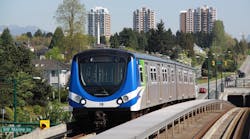This is the third iteration of the annual “topics to watch” list and when this began in January 2020, the then-called novel coronavirus was an interesting news story set well outside the North American transit industry. There was no indication that three years in, we would be looking at the industry framed by an active global pandemic. Despite COVID-19’s heavy influence on much of the world, the transit industry feels a bit more hopeful this time around.
The industry has remained nimble, stayed open to new approaches to service and has secured significant federal funding commitments in both the United States and Canada.
Here are the five topics we believe will carry heavy impacts on the industry over the next year.
Hiring, retention, training
This is one of the more topical subjects of the group, but critical if agencies are to develop and deliver COVID-19 recovery plans and offer new services. Operator shortages have affected agencies of all sizes, with temporary service reductions becoming a regular practice. Similar challenges have presented themselves on the maintenance side of the industry, as well.
Agencies are enhancing their benefits packages by increasing sign-on bonuses, referral bonuses and hourly pay. Additionally, a handful of transit entities have developed second chance training or hiring programs.
The Indianapolis Public Transportation Corporation (IndyGo) announced in May a revised background check protocol. A criminal background inquiry would not be made until a candidate has a conditional offer of employment. If a conviction within the past seven years is found, IndyGo will perform an individualized assessment of the situation. At the time of the protocol’s announcement, IndyGo President and CEO Inez Evans noted the policy not only extended employment opportunities for individuals but also helped support the agency’s goal, which is “all about opportunity.”
Early in December 2021, New Orleans Regional Transit Authority announced a partnership with JOB1 Career Solutions to create on the job training for offenders who successfully complete the requirements of the Louisiana State Penitentiary’s Auto Mechanic Apprenticeship Program upon release. The program will begin with bus mechanic and body repair technician trainees for a six-month trial period and the authority hopes to expand the program to additional careers in 2022.
Mobility mix
On-demand and micromobility options will continue to play an influential role in communities moving forward. These service options were emerging prior to the COVID-19 pandemic, but with so many coming into service during the pandemic, their value in preserving and enhancing mobility options has been established in communities of all sizes.
Franklin Regional Transit Authority in Greenfield, Mass., and Tompkins Consolidated Area Transit, Inc., launched their on-demand services for underserved communities, while King County Metro’s Skyway Community Van fills transportation gaps.
Integration of all mobility services is another component. This integration was highlighted in April 2021 through the magazine’s cover story on the Central Midlands Regional Transit Authority (The COMET), which looked at the “non-traditional” mobility offerings The COMET integrated into its mobility mix.
Another example of this integration is Brightline, the private intercity passenger rail service in southern Florida, which launched Brightline+, a door-to-door solution to ease the decision to travel by train and book a ride to/from the train station in a single app. In West Palm Beach, Fla., Brightline+ includes the brand’s bikeshare option, BrightBikes.
Continued focus on fleet sustainability
Low and zero-emission fleets are not a new trend, but the topic remains on the list due to its sustained newsworthiness. This magazine saw a 35 percent increase in stories covering zero-emission buses in 2021 versus 2020 and agencies are taking steps to ensure their fleets support a more sustainable future.
Of the 25 largest bus agencies in the U.S., 12 percent have a board-approved zero-emission transition plan for their fleets by 2030, four percent by 2035, 40 percent by 2040, 12 percent by 2045 and four percent by 2050. The remaining 28 percent have all studied or started their transition to zero-emission fleets, but do not have a formal plan in place.
A report from the Center for Transportation and the Environment published in May 2021 found the entire U.S. transit bus fleet could transition to zero-emission vehicles by 2035 at a cost of between $56.2 billion and $88.9 billion.
The Bipartisan Infrastructure Deal that was signed into law this fall contains significant funding to aid transit fleets in their zero emission transitions, including $5.6 billion in Low or No Emission Vehicle Competitive Grants and a new program that will provide $250 million to support passenger ferry transition to low- or zero-emission technologies.
Deliberate move toward equity
Transit should connect, not divide and those connections should be available to all. The pandemic forced transit providers to reassess who they serve and why.
As Nichole Gladney, vice president of Inclusion and Engagement at Keolis North America Inc., recently wrote in Mass Transit, “As the transportation industry faces an increasingly diverse ridership landscape, it requires a nuanced rethinking of how transit authorities and operators are reflective of the communities they serve.”
Staff positions dedicated to diversity, equity and inclusion efforts were established or expanded at agencies such as Sound Transit, Community Transit, Port Authority of Allegheny County and Central Ohio Transit Authority.
Enforcement practices were re-examined as fare citation diversion programs expanded and certain transit security programs evolved to include ambassador programs.
Universal basic mobility programs launched in Bakersfield, Calif., and Pittsburgh, Pa., and will evaluate the impact providing transportation options to disadvantaged residents will have.
Equity is among the four areas of priority the Federal Transit Administration (FTA) says transit funding included in the Bipartisan Infrastructure Deal will support. Specifically, FTA explains investments in the law will improve transit service for communities that have historically had more limited access to transit.
One key program established by the law is the All Stations Accessibility Program, which dedicates $1.75 billion to bring existing passenger rail stations or facilities into compliance with the Americans with Disabilities Act.
Smart fare structures
Arguably, the topic of right-sizing fares would fall under the umbrella of equitable practices. However, the technology development occurring within this sector, the new programs being piloted at various agencies and the debate to go zero fare or not was enough to move this topic into a category of its own.
While the zero fare debate stretches back years, suspending fares during the pandemic became a safety practice for agencies wanting to maintain physical distance between operators or other staff and riders. Some agencies found zero fare translated into a lessening of the pandemic ridership drop and, in the case of GRTC in Richmond, Va., a ridership increase.
GRTC recently secured a grant from the commonwealth to study the impacts of remaining fare free for three years. GRTC CEO Julie Timm noted fares were a “very real barrier” for community members at or below the poverty line and the move to zero fares means there is no longer a choice between “the cost of transportation and the cost of food or medicine.”
Not every system is in a position move to a zero fare model, but there are additional innovations occurring designed to deliver similar results.
In the Chicago area, the Regional Transportation Authority, Pace, Metra and Cook County began a three-year pilot program in early 2021 that targets communities where the portion of income spent on transportation, as well as commute times are high with discounted fares and more frequent service.
Revised fare structures and simplified fare structures have also been gaining in popularity, especially among transit networks that have adopted a smart fare collection system. An additional fare collection element our staff has been writing more and more about: fare capping, which has recently launched as part of the smart fare systems on San Diego Metropolitan Transit System, Omaha Metro, the Edmonton, Alberta region and the City and County of Honolulu Department of Transportation Services (to name a few).
How did we do? What topics do you think will capture the industry’s attention in 2022?
See how we did with our previous “topics to watch” lists from 2020 and 2021.

Mischa Wanek-Libman | Group Editorial Director
Mischa Wanek-Libman is director of communications with Transdev North America. She has more than 20 years of experience working in the transportation industry covering construction projects, engineering challenges, transit and rail operations and best practices.
Wanek-Libman has held top editorial positions at freight rail and public transportation business-to-business publications including as editor-in-chief and editorial director of Mass Transit from 2018-2024. She has been recognized for editorial excellence through her individual work, as well as for collaborative content.
She is an active member of the American Public Transportation Association's Marketing and Communications Committee and served 14 years as a Board Observer on the National Railroad Construction and Maintenance Association (NRC) Board of Directors.
She is a graduate of Drake University in Des Moines, Iowa, where she earned a Bachelor of Arts degree in Journalism and Mass Communication.







